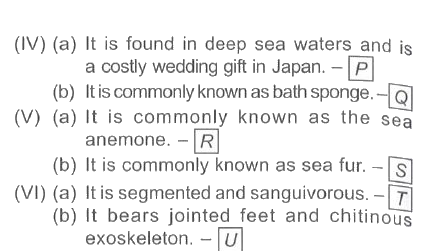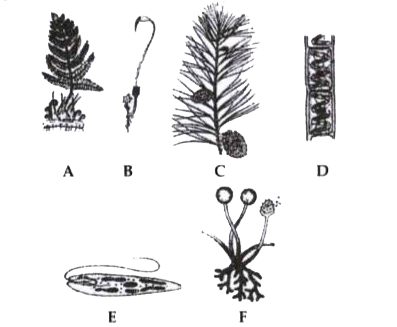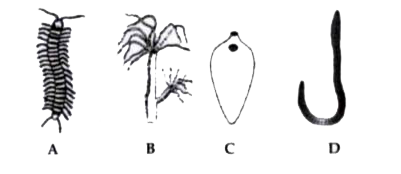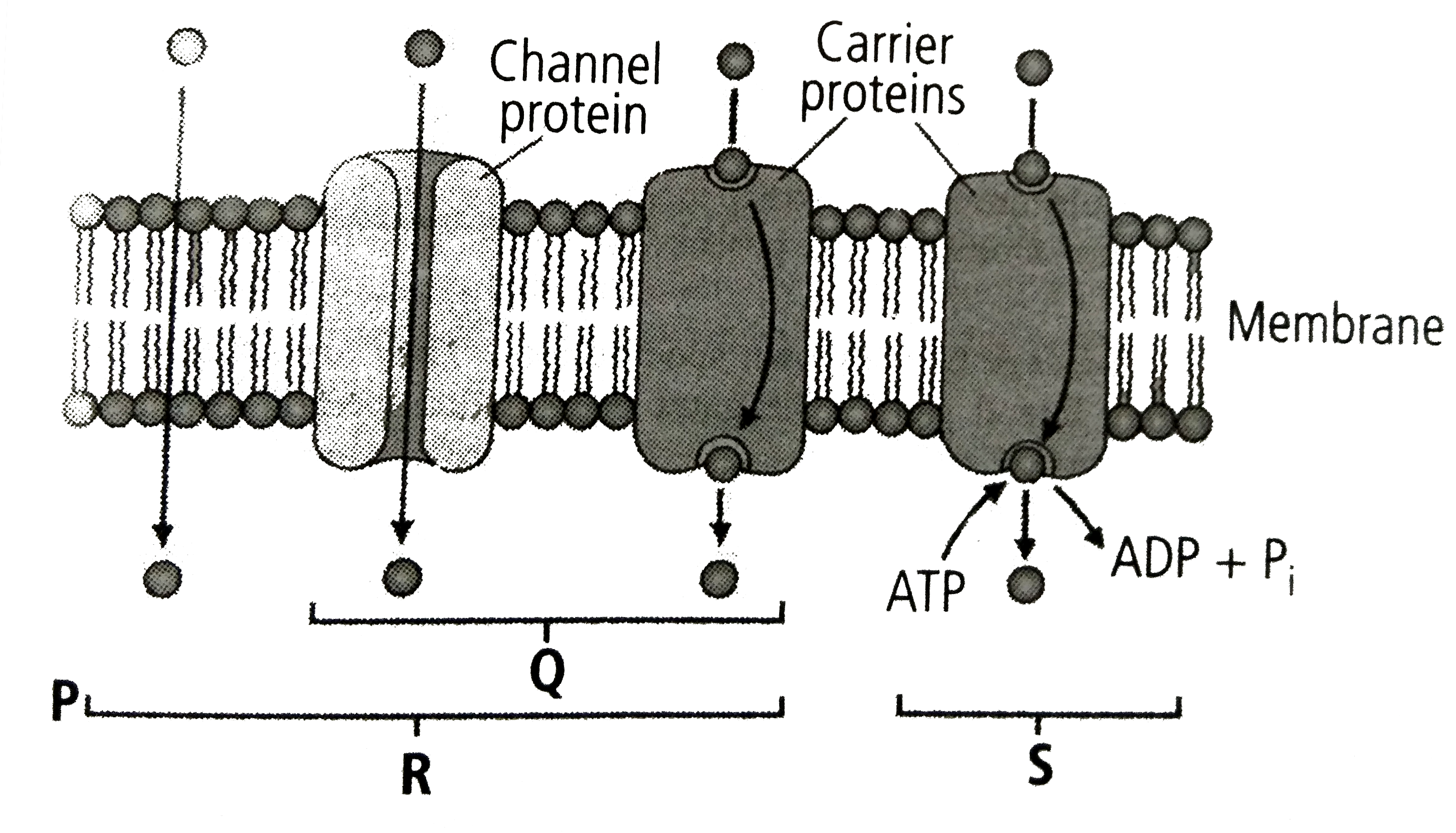Refer to the given dichotomous key and answer the following questions.


Identify organisms P, Q, R, S, T and U.
P-Euplectella, Q-Spongia, R-Adamsia, S-Obelia, T-Hirudinaria, U-Periplaneta
P-Fasciola, Q-Limax, R-Palaemon, S-Ascaris, T-Sepia, U-Wuchereria
P-Asterias, Q-Nereis, R-Tubifex, S-Loligo, T-Hydra, U-Enterobius
P-Pheretima, Q-Chiton, R-Antedon, S-Aphrodita, T-Aurelia, U-Sepia
The correct Answer is:A
Step by step video & image solution for Refer to the given dichotomous key and answer the following questions. Identify organisms P, Q, R, S, T and U. by Biology experts to help you in doubts & scoring excellent marks in Class 9 exams.
Updated on:21/07/2023Topper's Solved these Questions
- DIVERSITY IN LIVING ORGANISMS BOOK - SCIENCE OLYMPIAD FOUNDATION CHAPTER - DIVERSITY IN LIVING ORGANISMS EXERCISE - ACHIEVERS SECTION (HOTS)
5 Videos
- CLASS 9 SAMPLE PAPER FINAL 4BOOK - SCIENCE OLYMPIAD FOUNDATION CHAPTER - CLASS 9 SAMPLE PAPER FINAL 4EXERCISE - SCIENCE
2 Videos
- IMPROVEMENT IN FOOD RESOURCES BOOK - SCIENCE OLYMPIAD FOUNDATION CHAPTER - IMPROVEMENT IN FOOD RESOURCES EXERCISE - ACHIEVERS SECTION (HOTS)
5 Videos
Similar Questions
Refer to the following figures and answer the questions given below:

Identify figures A to F.
View SolutionRead the following information and answer the following question.
Six people P, Q, R, S, T and U are sitting in a row facing to the north. P and Q are sitting on the extreme ends of the row. T is sitting second to the right of the Q. There are two persons are sitting between U and R. P is sitting immediate right of R.
Who is sitting third to the left of S?
View Solution
Knowledge Check
A tissue made up of only one type of differentiated cells is
AP is an epithelial tissue whereas Q is a loose connective tissue.BT is either greatly reduced or absent but R is exclusively present in aquatic floating plants whereas Sis found in Cucurbita stems.CR is aerenchyma, S is collenchyma, T is xylem and U is phloem.DU is found in grit of guava, pear, etc., whereas the matrix of tissue P contains a flexible material called chondrin.Refer to the given dichotomous key and answer the following questions.
I. (a) The cells of tissue have walls. - Go to II
(b) The cells of tissue do not possess wall. - Go to III
II. (a) Tissue made of one type of cells. - Go to IV
(b) Tissue, made of more than one type of cells. - Go to V
III. (a) The tissue lines the alveoli of lungs. -P
(b) The tissue forms shock absorbing cushion around some vital organs. - Q
IV. (a) Cells of tissue contain air cavities and it provides buoyancy. -R
(b) The tissue provides mechanical strength and flexibility to young dicot stems and petioles. - S
V. (a) Tissue conducts water. - T
(b) Tissue conducts organic solutes. - U
Select the incorrect option regarding tissues P, Q, R, S, T and U.AP is an epithelial tissue whereas Q is a loose connective tissue.BT is either greatly reduced or absent but R is exclusively present in aquatic floating plants whereas S is found in Cucurbita stems.CR is aerenchyma, S is collenchyma, T is xylem and U is phloem.DU is found in grit of guava, pear, etc., whereas the matrix of tissue P contains a flexible material called chondrin.Refer to the given passage and answer the following questions. P, Q and R are acoelomate organisms whereas S and T are true coelomates. P possesses cellular level of body organisation whereas others possess tissue and organ level of body organisation. Q possesses special stinging cells called cnidoblasts. R is the first triploblastic animal and has flame cells as excretory organs. The body of S is metamerically segmented whereas T bears jointed appendages and chitinous exoskeleton.
Which of the following is incorrect regarding organisms P, Q, R, S and T?AP possesses endoskeleton of calcareous spicules whereas Q is always aquatic.BR could be a parasite which attaches to the body of host through hooks and suckers whereas S possesses metanephridia for excretion.CT sheds off its chitinous exoskeleton periodically during its growth which is referred to as moulting.DNone of these
Refer to the following figures and answer the questions given:

Identify figures A to D.
View SolutionRefer to the given dichotomous key and select the correct option regarding P, Q, R, S and T.
I. (a) Genetic material is not enclosed in nucleus. - Go to II
(b) Genetic material is enclosed in nucleus. - Go to III
II. (a) Lacks cell wall. - P
(b) Possesses cell wall. - Q
III. (a) Unicellular organism - R
(b) Multicellular organism - Go to IV
IV. (a) Plant body is sporophytic and water is required for fertilisation. - S
(b) Plant body is sporophytic and water is not required for fertilisation. - T
View SolutionRefer to the given keys and answer the following question.
P. membranes surrounding vacuoles
Q. shelves produced by the folding of inner mitochondrial membrane
R. stacks of membrane bound discs with chlorophyll and carotenoids
S. develops between two adjacent plant cells
Which of the following is not correctly matched?
View SolutionRefer to the given figure and identify P,Q,R and S.

View SolutionRefer to the given dichotomous key. Identi fy P -T and select the incorrect statement.
I. (a) It is unicellular organism. - Go to II
(b) It is multicellular organism. Go to IV
II. (a) It possesses well organised nucleus. Go to III
(b) It lacks well organised nucleus. -P
III. (a) Nutrition is parasitic. -Q
(b) Nutrition is mixotrophic. -R
IV. (a) It possesses chlorophyll. - S
(b) It lacks chlorophyll. -T
View Solution
